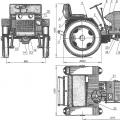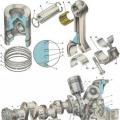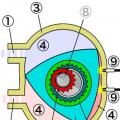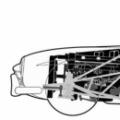Which car are you the owner? - Front wheel drive, rear wheel drive or all wheel drive. Do you understand the mechanisms of a car, do you understand what justifies its power and maneuverability on the road, especially when descending and ascending? Often, the operation of cars is on a whim, only a part of the owners with their vehicle on the "you". An experienced and attentive driver clearly understands which part needs to be replaced as planned, whether the rearrangement of the wheels is relevant, which scheme is suitable for this. Not everyone, for example, can afford to allocate up to 20-30,000 rubles from the family budget for the purchase of a set of winter and summer tires twice a year. In order to save money, car owners are looking for acceptable ways out of the situation. And there may be several of them.
There may be several ways out of the situation, but let's pay attention to the simplest and most popular - the rearrangement of the wheels, the scheme of the process has never been complicated, and even more so, several variations are attributed to it. Choose practically without limits!
Service station employees recommend paying attention to the condition of the wheels, and if impressive numbers indicating the mileage already appear on the dashboard, and it is somewhere between 5000-10,000 kilometers, then the rearrangement of the wheels is shown, the scheme is selected as desired. You should be extremely careful if you bought a used car from your hands, because then dashing craftsmen could twist the mileage indicators, hiding the true wear and tear of the mechanical "filling" of the car previously put up for sale. It is then worth being guided by the state of the tread pattern. We noticed wear on the front or rear wheels, assessed them as a percentage, and decided to undertake a rearrangement of tires according to the scheme. The following reasons for wheel relocation are determined:
- Uneven tire wear.
- The need to reinforce one or another pair of wheels, respectively, for front-wheel drive and rear-wheel drive cars.
- The desire to extend the life of tires, to improve their condition by changing the load level for a while.
- An unforeseen traffic situation, emergency repairs in the field.
What you need to swap tires
There are tools in the trunk of any car, many of which are useful for repair work. The rearrangement of the wheels on the car is conceived, the scheme, as expected, is available, then the following improvised means will be needed:

When undertaking such a painstaking procedure yourself, try to enlist the support of friends or family. Undoubtedly, you need support, help. When repairing a car, there is always something to support, give, light up, get, move, substitute, and so on. The list of actions can be endless!
Wheel swap schemes
Rearrangement of wheels is carried out, the scheme is selected for this in advance. All the positive aspects of the rotation are assessed, possible miscalculations are predicted. The main thing to consider is how to rotate in a front-line, rear-wheel-drive, all-wheel drive complexation, whether it is worth adding a spare wheel to the rearrangement, because it was always assigned a lower load.
Diagram for front wheel drive cars with non-directional pattern

Scheme for rear wheel drive cars
- Crosswise adjustment towards the rear axle.
- Crossing, starting from the driving axle, when the left front axle changes the wheel with the rear right, and also from the front axle the right - with the rear left.
Scheme for all-wheel drive cars

Rearrangement of wheels taking into account the spare wheel
If we introduce a spare wheel into rotation, then we can achieve an increase in the wear threshold of the entire tire set by an average of 20%. But be careful not to use a spare tire if it is in perfect condition and four wheels are already bald. The reason - there is a difference in radii, it can provoke damage to the transmission.
 Rearrangement of wheels on the car taking into account the spare wheel
Rearrangement of wheels on the car taking into account the spare wheel Thus, it is not difficult to rearrange the wheels, the main thing is to understand why it is necessary and how to perform this rotational procedure. Car enthusiasts claim that such routine actions will lead to the result - an increase in tire life.
A brand new set of tires can live from 80 thousand kilometers or more, however, this applies to ideal working and road conditions. But we can create some of these conditions ourselves. Just a couple of simple rules, and the service life of tires can be easily extended by 30-40 thousand kilometers.
Tire wear
Of course, many factors affect the lifespan of a car tire. This is the driving style, and the class of the car, its technical condition, the type of tires themselves. And, of course, the tire life of a neat summer resident who drives a car a couple of times a year and an aggressive street racer constantly blowing smoke at the start will be completely different. An important factor affecting the lifespan of rubber, the degree of deterioration of its elements, be it ball joints, bushings, etc. It is also necessary to set the correct camber, maintain optimal tire pressure.
Why swap tires
Another way to extend the life of your tires is to rearrange the wheels. Previously, experienced drivers often used this technique, for many it was a rule, but today it is practically forgotten. How can changing tires in places help? It's simple, different wheels in the car are subjected to different loads, which, in turn, leads to obvious differences in the structure and degree of tire wear. For example, the front tires hold most of the weight of the car, because in the vast majority of cars the heavy engine is located in front. The load is increased even more when, up to 80 percent of the weight falls on them during hard braking. Then, the front wheels are constantly turning, which cannot but affect their accelerated wear.

Rotation period
The wear structure of the front and rear tires is different, on the front the edges of the tread are grinded, while the rear tires lose the middle part. Timely rotation of the wheels will make it possible to make this wear more even: the rear tires will begin to wear off on the sidewalls, while the front tires will begin to wear flat. Of course, you can simply change to new front tires if you have enough extra money, but it's easier to just swap the tires, extending their life by one and a half times. Moreover, the tire manufacturers themselves advise to rearrange the tires every six months or every ten thousand kilometers. And to do this, you do not have to take separate additional actions, because every six months we already change our cars from summer to winter tires and vice versa. You just need to swap them.

Permutation order
The permutation scheme may be different, but it is correct to do it as follows: we put the rear tires forward in the same order as they were, that is, left to left, and right to right. The front tires should be placed on the rear axle in an intersection, that is, we put the left front on the right rear side, and we do the same for the right front.
But there is one significant nuance here - the asymmetric pattern on the tread. If you have such tires, then the rearrangement is done without changing the beads. On powerful cars or on sports cars, wheels of different sizes are often installed, in this case the tires are swapped only along the sides, from right to left. And before each shift, carefully study the labeling of your tires.

Tire swap diagram
For safe driving and reliable driving, you cannot do without putting new tires on the car. However, rubber is not eternal and its wear cannot be uniform, for various reasons, on all wheels. Of course, no one is tempted to change all four tires at the same time in order to improve traction and steering information.
So draw a rabbit out of the hat. Help you save money - rearranging tires on your car. The rotation process is usually carried out during the change of seasonal tires at a service station. But tire wear does not depend on the season, but arises from the daily use of the car. And the chauffeur needs to know when to change the tires and how to do it himself.
Why is this needed?
Car tire wear is an uneven process. To begin with, the front wheels deteriorate faster than those on the rear. After all, the front of your car accounts for about 60% of the total weight. The erasure of the front tires is also affected by turns. When driving on the right side of the road, we turn much more to the left than to the right.
Consequently, the front right tire is subject to wear more than others. rearrangement of wheels will help. This will provide you with significant savings in machine costs and predictability of steering effort. And, like a real man, you can change the tires yourself on your car. Not necessarily in pursuit of savings, but even so that your significant other can see that a man is sitting inside the "white collar" too.
When to do wheel rotation
Each vehicle comes with a manual. If for some reason you do not have such a booklet, download the manual from the Internet. Among the tips for car maintenance, there will definitely be a tire swap pattern. Usually rotation is carried out after 5-10 thousand km. mileage, or, to make it easier to remember, with each oil change.
Tools
 Autojack. The jack, which is part of the required minimum of tools in the trunk of the car, is designed to replace a punctured wheel on the road. Changing all four wheels with it will be a rather laborious and time-consuming process. It is easier and safer to use a hydraulic jack that will lift one side of the machine at a time.
Autojack. The jack, which is part of the required minimum of tools in the trunk of the car, is designed to replace a punctured wheel on the road. Changing all four wheels with it will be a rather laborious and time-consuming process. It is easier and safer to use a hydraulic jack that will lift one side of the machine at a time.
Jack stand. Security is absolutely essential. If you don't want to waste money on purchasing an industrial stand, which is reasonable, you can replace the store one with one built from improvised means. For example, it may well be replaced by a building block covered with a board on top so as not to scratch the bottom.
Key. In this case, everything is clear.
Rearrangement of wheels
 Before you start unscrewing the nuts, decide on the scheme according to which the wheel rotation will be carried out. There are several nuances to consider here. First, look at your tires and see if they are directional or non-directional. This is important for many cars.
Before you start unscrewing the nuts, decide on the scheme according to which the wheel rotation will be carried out. There are several nuances to consider here. First, look at your tires and see if they are directional or non-directional. This is important for many cars.
Rotation of wheels with the inscription "ROTATION"
 Directional tires are easily recognizable by the distinctive 'ROTATION' mark and the directional arrow on the side. The tread pattern of such wheels is designed to rotate in a strictly defined direction. To change them, simply swap the right front and rear tires. Do the same operation on the left side.
Directional tires are easily recognizable by the distinctive 'ROTATION' mark and the directional arrow on the side. The tread pattern of such wheels is designed to rotate in a strictly defined direction. To change them, simply swap the right front and rear tires. Do the same operation on the left side.
If you have non-directional tires
Non-directional tire tread allows you to install tires on a car in any place and on any side, since there is no strictly specified direction of rotation. If you have a rear-wheel drive machine, put the wheels removed from the front on opposite sides. So, the front tire on the left side will be in the back of the right, and the right tire in the place of the left rear. The rear tires are simply fitted in the front without changing sides.
In front-wheel-drive cars, the opposite is true: the front wheels are moved back without changing sides. And the rear left to the place of the right front, the right rear to the place of the left front.
Rotation of five wheels
 Actually, in the car, taking into account the spare, there are 5 wheels, not 4. But this statement in relation to modern car spare wheels is rather controversial. They are not designed for long-term use - they have a shallow tread, modest size and weight. Their task is to reach the nearest tire fitting.
Actually, in the car, taking into account the spare, there are 5 wheels, not 4. But this statement in relation to modern car spare wheels is rather controversial. They are not designed for long-term use - they have a shallow tread, modest size and weight. Their task is to reach the nearest tire fitting.
It is quite another matter if you have a full-fledged wheel or your jeep on your "spare tire". A 5th wheel rotation scheme is suitable here. Moreover, with a "spare wheel" tire running time increases by 20% and the tread wears out equally on all tires.
So front-wheel drive. "Spare wheel" is put in place of the right rear wheel, the left front - instead of the spare. Rear right - in place of the left front, the left rear with the right front change places.
Formula 4x4 and rear wheel drive cars
The left front - in the place of the spare, the spare - in the place of the right rear. Left rear - in place of the left front. The right front is replaced by the left rear. Right back - in place of the right front.
Rotation
1. To ensure our own safety, raise the parking brake handle (of course, it must be serviceable).
2. Loosen the wheel nuts. Do not unscrew them completely before lifting the wheel on the jack.
3. Raise the wheel on a jack or the entire side if you are the owner of a hydraulic jack. We put a stand under the raised side. We lower the jack. Having finished with one side, we carry out the same operation with the other. It is much easier to rotate if all wheels are available for replacement. Of course, you can change them one at a time, but this is a matter of choosing a driver and having free time.
4. They removed the tires and made their rearrangement according to the chosen scheme. Tighten the nuts in order - one against the other.
5. Lower the machine onto its four “fulcrum” points. We tighten the nuts with a wrench diagonally according to the star principle.
It is done! The rearrangement of the wheels is complete! Happy journey to you: no rod, no nail.
EXPERIENCE EXCHANGE
In the article “Rubles and kilometers” (“Behind the wheel”, 1987, No. 10), it was casually said that the resource of tires can be increased if the spare wheel is not put into operation according to the recommendation of the vehicle operating instructions. Many people ask for more details.
The recommendation to rearrange the wheels so that the tires wear evenly appeared, perhaps, at the same time as the car wheel, and since then has been wandering from one factory manual to another. It is quite simple: periodically swap the wheels so that each one, including the spare wheel, works in all positions - front and rear, left and right. True, recently a reservation has begun to appear in the technical literature: a rearrangement is needed only when uneven tire wear appears. Let's figure out what's the matter.
One tire can wear out faster than others due to an incorrect position on the car, play in the hub bearings or in the steering drive hinges, etc. This applies to the front wheels, although the "Cossacks" have cases of accelerated wear of tires of only one rear wheels due to deformation of the lever. The two front tires on classic cars wear out faster than the rear ones, because they do not always occupy the optimal position relative to the road while driving, and besides, they cover a longer distance, overcoming turns. The "Cossacks" have a different picture: here the rear tires wear out faster, firstly, due to the greater load, and secondly, due to the more frequent violation of the rear wheel alignment angles. In front-wheel-drive vehicles, the front wheel tires wear out faster than the rear ones, since additional slippage occurs at the drive wheel at the point of contact of the tire with the road as a result of the transition of the rubber from the compressed state to the stretched state. And the load on the front wheels of these cars is greater than on the rear.
So, it is impossible to get rid of uneven wear of tires. Why, then, are they gradually moving away from the traditional recommendation to periodically rearrange the wheels? The main reason is that in the new location, the tire wear rate increases in comparison with what it was before the rearrangement. After all, each tire, in its place, seems to have been running in to the road, and after the rearrangement, the specific pressure on a part of the tread protrusions increases, that is, the running-in process begins anew. It is also bad when, as a result of the rearrangement, the direction of rotation of the wheel changes - in this case, the accumulation of fatigue phenomena in the threads of the tire cord accelerates.
But if the wheels are not rearranged at all, then the tires will not come to the finish line at the same time, which is also bad, since the resource of the two tires will not be fully used. How to be? Based on my experience, I propose the following, in my opinion, the most rational scheme for operating tires.
Classic cars.On a new car (denote tires, as shown in Fig. 1, a), it is advisable to immediately measure the initial depth of the tread grooves - usually it is 9 mm. Operation of tires is allowed up to a depth of 1.5 - 1 mm, so the new tire has a "wear margin" of 7.5-8 mm. So, if the tires are rearranged, as shown in Fig. 1b, at the moment when the front wear is 1-1.5 mm more than the rear, then all four tires will come to the finish line at the same time. Note that the front wear at the moment of rearrangement will be more than a halfwear margin new. (When operating first "Moskvich-408", and now IZH-21251, I rearranged the tires after running about 30 thousand kilometers.)
When the tires are completely worn out, the spare wheel and three new tires must be put into operation, as shown in fig. 1, c. If possible, the old ones should be put into weld or exchanged for restored ones (in Fig. 1 they are shaded), and a spare set of five tires should be attached somewhere in the room (a balcony with its fluctuations in temperature and humidity is not the best place for storage).
The fourth permutation is shown in Fig. 1, d, and the fifth - in Fig. 1, e. Now it is advisable to leave new tires on the front wheels until they are completely worn out (Fig. 1, f). The fact is that welded-on tires often have a large imbalance, and wheels with them are not even taken to balance at the service station.AND on the rear wheels, the imbalance is not so terrible, since the force from it is perceived by the widely spaced axle bearings.
The last picture shows that there are three weld-on wheels left in stock. This is theoretically. In practice, you will probably have to prematurely part with one or more tires due to accidents (cuts, punctures) or due to internal defects (cracks, cord delamination, etc.).
The above is also true for the "Cossacks", only this car will have everything "the other way around" - the tires of the rear wheels wear out faster.
Front wheel drive cars (fig. 2). In principle, the same wheel arrangement is applicable here. But, given that the rear tires wear out here almost twice as slow as the front ones, you can simplify things and not rearrange the wheels, if, of course, you can get a new set of tires in time or purchase at least two new ones (Fig. 2, b) ...
The proposed schemes in comparison with the classical scheme of wheel rearrangement allow increasing the resource of each tire by 15-20%. But it is advisable to use them if you do not intend to change the type of tires, for example, universal - for winter, diagonal - for radial, etc. When a replacement of this kind is planned, you need to apply the classical permutation scheme so as not to create yourself the problem of a spare wheel other than the rest. After all, the use of different types of tires on a car greatly impairs its stability and controllability and therefore is not allowed by the traffic police.
When independently performing a change in the arrangement of the wheels on the machine, it must be remembered that the scheme of their rearrangement depends on.
Why rearrange the wheels
Every car, regardless of whether it is front-wheel drive, rear-wheel drive or four-wheel drive, the tires of the wheels located on the drive axle wear out more intensively than on the free one.
Providing uniform wear of their protectors is possible only by periodic rotation of the car wheels.
For most cars, this procedure is recommended to be performed every 10 thousand kilometers.
Wheel rotation methods
For tires with directional tread pattern, wheel change is performed by swapping the right front wheel with the right rear wheel, and the left front wheel with the left rear wheel.
As for all other wheels, some sources describe their rotation schemes separately for front-wheel drive, rear-wheel drive and all-wheel drive types of cars.
It is not clear why complicate what in fact can be done easily and simply?
Moreover, this method of rearranging the wheels is universal and does not depend on the type of machine drive.
It is performed as follows:
 1. The left front wheel is installed in place of the right rear wheel;
1. The left front wheel is installed in place of the right rear wheel;
2. The right front is installed in place of the left rear wheel;
3. The left rear wheel is installed in place of the left front one;
4. Right rear - in place of the right front wheel.
However, this is exactly the case when it is better to see once ...
Good luck to you! Not a nail, not a rod!




